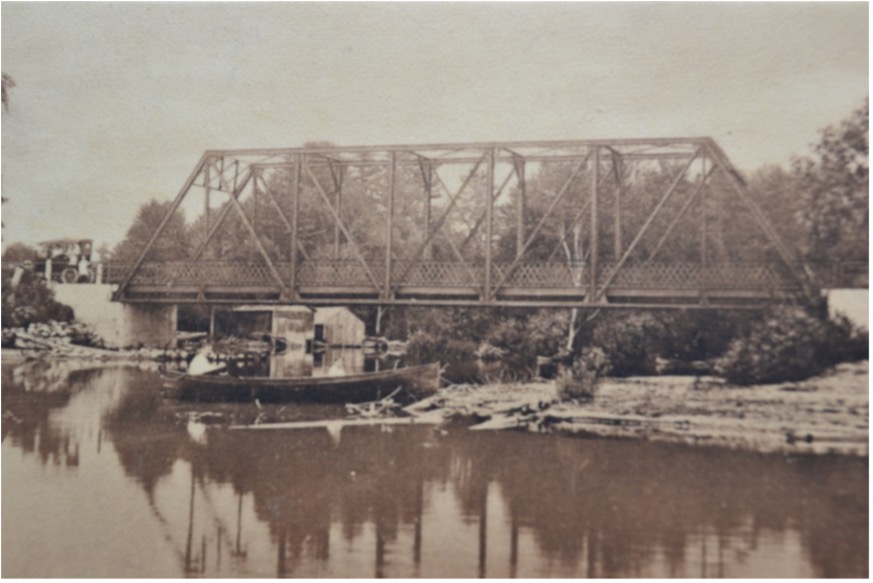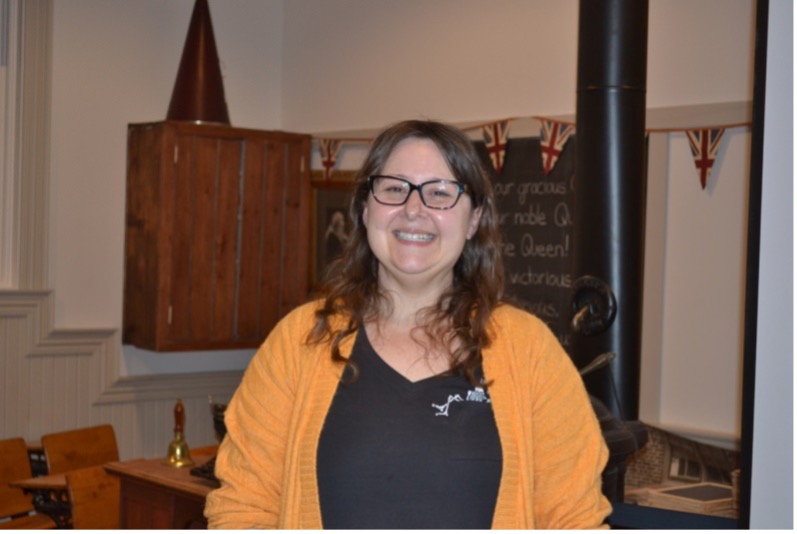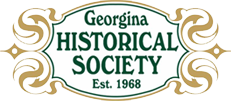Click to Download the PDF
Download the Word Doc
President’s Message
Spring has finally sprung, but Mother Nature is reluctant to let us enjoy the warmth that usually comes with the change of season. As I am writing this, a week after the big ice storm, some people are still struggling with no power and continue to gather broken limbs from their properties. However, we do know that we are on the right side of spring, and soon the ice will be gone from Lake Simcoe, the flower beds will blossoming, and all will be bright and sunny.
World events continue to keep us at the edge of our seats. Who would have predicted, even a year ago, that everything would be in the state that it is today. History is being made every day, and it is hard to keep up.
Don’t forget the grand opening of the Georgina Pioneer Village on Saturday May 31. It would be great to see a big turnout of Georgina Historical Society members at the event, so mark it on your calendars. It is not every day that your historic village achieves fifty years of age, and we need to celebrate the people who had the forethought so long ago to save these buildings and artifacts for future generations.
I hope that all is well with you and yours, we’ve got another interesting newsletter for you thanks to Bob Holden, I hope that you enjoy it.
Bye for now,
Paul Brady, President
History Repeated?
The article below is copied from the March 2025 edition of the newsletter for the Newmarket Historical Society. As it is very timely, they have kindly consented to allow us to reproduce it in our own newsletter.
Image below – a political cartoon by Dorman H. Smith regarding the Hawley-Smoot tariff bill passed by the American Congress in 1930. The act was a major contributor to a deep worsening of the Great Depression initiated by the stock market crash of October 1929.


A Day in the Life at Georgina Life
Georgina Life, the local information show presented by Rogers Cable, has been on the air for years. Though only available to Rogers’ customers, it is a great medium to learn about Georgina news, events and agencies that make Georgina such a vibrant place to live.
Paul Brady, has appeared on Georgina Life numerous times as the president of the Georgina Historical Society, and he always has a great time there. March 17, 2025 found him once again at the Rogers studio in Keswick. The topic for the day was the different rail systems that serviced Georgina over a century ago. This is a wonderful place for us to share our vibrant history with our local community.
Situated at the Keswick Ice Palace, Rogers’ television studio goes unnoticed by most passers-by. Once inside though, you are presented with a full-on television studio that you would never know existed if you didn’t peek inside. The first couple of times for Paul on the show, it was broadcast live, making for a very exciting session. It is now pre-recorded so much of the pressure is off, but there is still the need to keep your facts straight, and to not freeze up.
The gentleman who keeps things on the rails is Jeremiah Breton, the Rogers employee who puts everything together.



The rest of the crew, including the gracious hosts Lynda Quirino and Grant Peckford, (above left) the wonderful camera operators and also our friend Bette Banks (above right), who acts as receptionist, microphone installer and all-round go to person, are all volunteers. It’s amazing that these people would dedicate so much of their own time and energy to keep the community informed and entertained, and to do it all in such a professional manner.
Photos in this article by Paul Brady
April Fool!! A Brief History
The following ‘history’ of April Fool’s Day has been adapted and edited from two internet resources found at https://historyguild.org/april-fools-the-history-behind-the-worlds-greatest-day-of-pranks/ and https://www.history.com/articles/april-fools-day. Ed.
All the world loves a good April Fools’ Day prank – from telling your schoolmates it’s a non-uniform day to assuring a co-worker the boss has definitely given everyone the day off, April 1st is a day of big and small pranks all around the world. While mostly celebrated in Western countries such as those in Northern Europe, America, and other English-speaking countries like Britain, Australia, Canada, and New Zealand, much of the world knows of and sometimes takes part in the light-hearted tradition of April Fool’s Day.
But where does it come from? The truth is, no one knows for sure. A day of playing practical jokes, spreading hoaxes, and generally messing with your friends and family for fun, the history of April Fool’s Day is uncertain. Here’s what we do know about the day, along with some of the best pranks ever pulled.
There are many historical origins for April Fool’s Day, though most originate in Europe. One leading explanation comes from France in the 16th Century. Aiming to counter and respond to the rising protestant movement in Europe, Pope Gregory XIII called the Council of Trent which convened between 1545 and 1563, and set out to unify Catholic doctrine. With this came the idea of the Gregorian calendar. Europe’s astronomers had recommended to the Pope to fix the Julian calendar which was losing 12 minutes every year. Soon after in 1582, King Charles IX of France reformed the calendar along with most other Catholic nations of Europe. This moved the start of the year from April 1st to January 1st.
Not everyone got the memo, and people who mistakenly continued to celebrate the New Year in April were mockingly called “April fish” (poisson d’avril) and became targets of pranks and hoaxes, starting with the placing of paper fish on a victim’s back. The term “April fish” persists in French-speaking areas, and likely comes from the abundance of easily caught fish in streams during early April – much like gullible people being pranked.
While the Gregorian calendar change is but one leading historical explanation of the day, historians have also connected April Fools’ Day to the ancient Roman festival of Hilaria, celebrated at the end of March. Like April Fools’ Day, during Hilaria Romans would dress up in disguises and mock fellow citizens and even magistrates. Given the timing and jovial nature of the festival, it may be related to modern April Fool’s – though no certain link has been established.
April Fools’ Day spread throughout Britain during the 18th century. In Scotland, the tradition became a two-day event, starting with “hunting the gowk,” in which people were sent on phony errands (gowk is a word for cuckoo bird, a symbol for fool) and followed by Tailie Day, which involved pranks played on people’s derrieres, such as pinning fake tails.

In modern times, people have gone to great lengths to create elaborate April Fools’ Day hoaxes. Newspapers, radio and TV stations and websites have participated in the April 1 tradition of reporting outrageous fictional claims that have fooled their audiences.
Left is a prank with mashed potatoes and gravy masquerading as a sundae. In 1957, the BBC reported that Swiss farmers were experiencing a record spaghetti crop and showed footage of people harvesting noodles from trees. In 1985, Sports Illustrated writer George Plimpton tricked many readers when he ran a made-up article about a rookie pitcher named Sidd Finch who could throw a fastball over 168 miles per hour.
In 1998, after Burger King advertised a “Left-Handed Whopper,” scores of clueless customers requested the fake sandwich. Google notoriously hosts an annual April Fools’ Day prank that has included everything from “telepathic search” to the ability to play Pac Man on Google Maps.
For the average trickster, there is always the classic April Fools’ Day prank of covering the toilet with plastic wrap or swapping the contents of sugar and salt containers. Hope you had some fun on April Fool’s Day!
Our Pioneer Ancestors
The following article was written by Susan Hoeg about her ancestors and may be found online at https://georginaisland.com/writing/history-of-georgina-island/. We have reproduced it here to share our Chippewa neighbours’ early settlement and their history in Georgina to our membership and readers. Ed.
The Chippewa’s of Georgina
By Susan Hoeg
Life on Georgina Island began in the early 1800’s. The Department of Upper Canada wanted to separate the Indians from the white settlements, putting them on reservations was a way of accomplishing this.
After a nomadic way of life they found it difficult to stay in one area. In 1826, camp meetings were held by the Methodist missionaries who worked vigorously to convert Indians to Christianity. Schooling was encouraged and children were placed with mission families. They were trained to spread the Christian faith and were forbidden to practice their Native Teachings or to use their Native tongue. Boarding schools were to follow, taking children away from heart broken families.
In the late 1820’s, the Indian Department of Upper Canada began to relocate the Lake Simcoe Indians. The Indians were blamed for destroying wildlife so they were encouraged to farm.
Snake Island was the first island the Indians settled on in Lake Simcoe. With more pressure to farm, they moved to the larger and more isolated Georgina Island. Only a few remained on Snake Island. The population on Georgina Island in 1876 was 131. They gradually changed their lifestyles, making the island their home.
About 1900 my grandfather built our log house. This is the warm loving home I spent my childhood in. My grandfather always won a prize for the best garden. Strawberries, raspberries and a variety of vegetables ensured enough food for the hard winters.
He rowed across the lake in a boat he had built. Every week the supplies were shopped for in the nearby towns. Hours were spent carving ax handles while my grandmother made beautiful baskets trimmed with sweet grass and porcupine quills. They would then take them to the villages and sell or trade them for food or clothes.
In the spring, maple syrup boiled vigorously in big black pots. Medicines were gathered in the woods. The women nursed the sick and delivered the babies.
We had an Indian Agent who looked after the affairs of our people. He always frightened me. Our men and women fought in the wars, some never returned. In 1961 Native people were finally able to vote in the Federal elections. They were also then allowed to bring alcohol onto the reserves. In the early 1950’s the telephone was brought to the Island by underwater cable, then hydro arrived in 1959.
Today we enjoy a new ferryboat and hover craft. Our revenues come from leased land on Fox, Snake and Georgina Island. We have an elected Chief and four councilors. Our Island membership is 600 with 155 members residing on our reserve. We enjoy a new Community Centre, Health Centre, United Church and a Public School. Classes are taught in Native language, art beadwork and traditional teachings. We have a ball team and a hockey team; we enjoy Powwows and Native dancing.
Self-government is in the future. Our way of life is changing; we hope and pray it’s for the better.
Where in Georgina?
Here’s our mystery location picture for April. This one should be easy; it has survived over a hundred years as one of the most picturesque structures in Georgina. Its appearance was drastically changed this past fall, but it still exists under the ugly new barrier.
Last month’s picture was an aerial view of Pollock Motors in Keswick, taken in the late 1950’s. This Pontiac and GMC dealership was located at Church Street and the Queensway, where the apartment building is now. It went through several different owners before being removed sometime in the 1990’s.

Our March Speaker
By Paul Brady
Melissa Matt, the curator at the Georgina Pioneer Village, was the featured speaker for our general meeting for the month of March. Her topic was St. Anthony’s Catholic Church in Virginia, specifically the cemetery, and as usual Melissa did a great job with her presentation. The capacity audience enjoyed Melissa’s well researched and informative talk, and it was fascinating to hear the stories. We learned about consecrated and non-consecrated grounds, that Virginia was originally called Frenchtown due to large number of French settlers there, and lots of local folk lore and forgotten happenings. Thank you again Melissa for bringing your presentation to us, it was enjoyed by all.

This Month in History
1838 – 1837 Rebellion – Nine prisoners from Dr. Duncombe’s Rising near Brantford are sentenced to death; three are reprieved and the six remaining are to be hanged April 20. Hamilton, Ontario
1869 – Noon cannon on Parliament Hill fired for the First time. Ottawa, Ontario
1866 – Fenian Raids – Irish Fenians invade Indian Island, near Campobello; on April 18, the US military disarm and disperse the invaders by authority of the Neutrality Act. Campobello, New Brunswick
1871 – Parliament passes Act to create uniform currency in Canada; sets denominations of currency as dollars, cents and mills. Ottawa, Ontario
1912 – Two young wireless radio operators, Robert Hunston and James Goodwin, hear the first distress call from the luxury liner RMS Titanic, en route to New York south of the Grand Banks.
1975 – Ontario Court of Appeal rules that divorced women can sue their former husbands for damages. Toronto, Ontario
News
Volunteers will be needed to man our refreshment booth at Music in the Streets, Saturday, June 28th, our booths at the market in June and July, and at the opening of the Village; details to follow on times and dates. Volunteers are also needed to staff the buildings for the 50th anniversary celebrations on May 31st.
This year your Board has decided to take a pass on Harvestfest for 2025. Kim Brady, our chair for the past three years, and Bob Holden, our music co-ordinator, have both been involved with it for the past several years and will not be available this year. We have put out feelers for volunteers to take their places but no-one has come forward as yet. Their roles involved considerable time and effort. Anyone coming forward would have to be prepared to commence working on this event immediately as once past March it becomes very difficult to arrange vendors and musicians.
Melissa Matt is seeking items for a 1970s display to help commemorate fifty years since the Village‘s founding. Melissa is especially looking for the following items: a braided rug, in shades of brown; Curtains (in shades of brown, beige, orange or yellow); 1970’s magazines, catalogues, etc.; Man’s lunchbox; Electric Typewriter or other office supplies suitable to the era; and Candle holders or other table service suitable for the Noble House dining table, in shades of gold/orange/brown. Please let her know if you can help with these items. They would be on loan for the summer and would be within reach of the visiting public, except those items intended for the Noble House. Melissa may be contacted at 905-476-4301 Ext. 2284. A new handyman has been contracted for the Village this summer season. His name is Michael Patrick.
Events
Tuesday, April 15 – At our general meeting Former Georgina Mayor Rob Grossi will share stories of Georgina ; at the schoolhouse in the Georgina Village Museum. Meet & Greet 6:30 pm meeting at 7:00 pm.
Monday, May 5 – Board Meeting, Quilter’s Cabin, to meet at 1:30 pm for anniversary planning & at 2:00 pm for the regular meeting.
Tuesday, May 20th – General Meeting, Georgina Pioneer Village schoolhouse 7:00 pm
Saturday, May 31 – Golden Anniversary Celebration of the Georgina Village Museum at the Village all day.
Saturday, June 28 – Music in the Streets, Georgina Pioneer Village 9:30 am -5:00 pm
